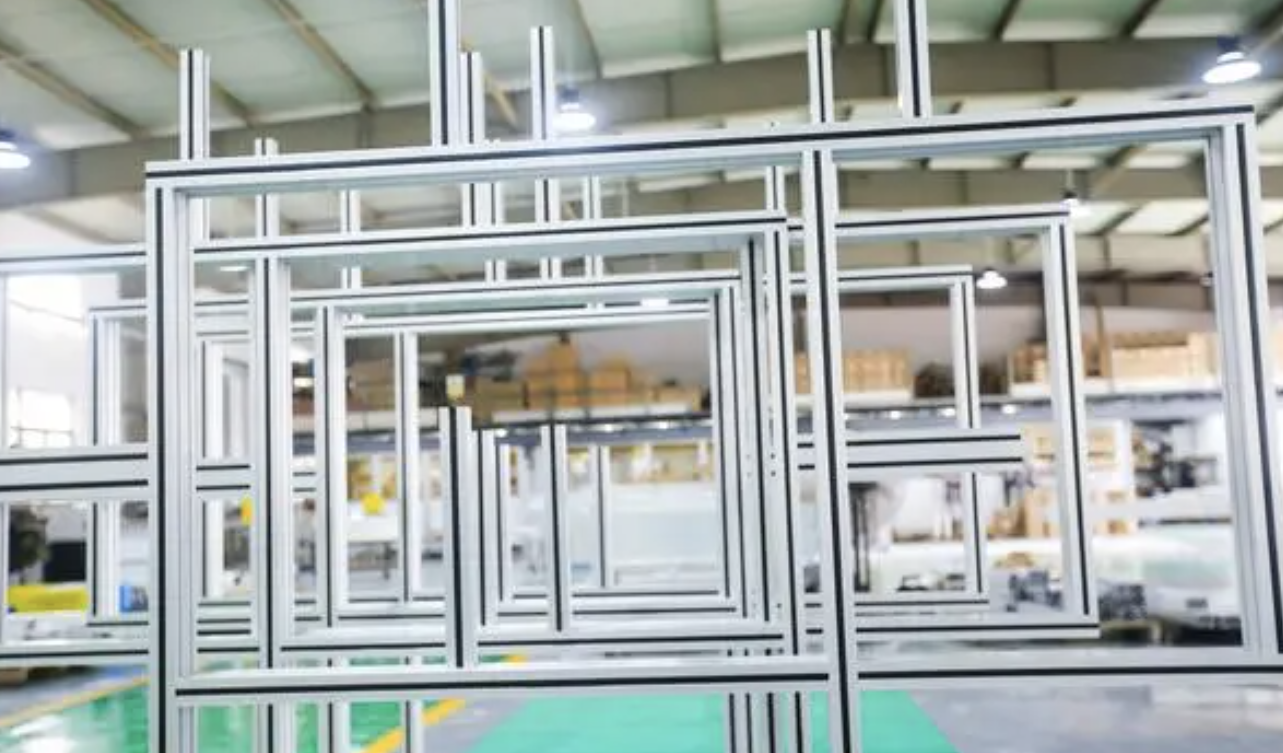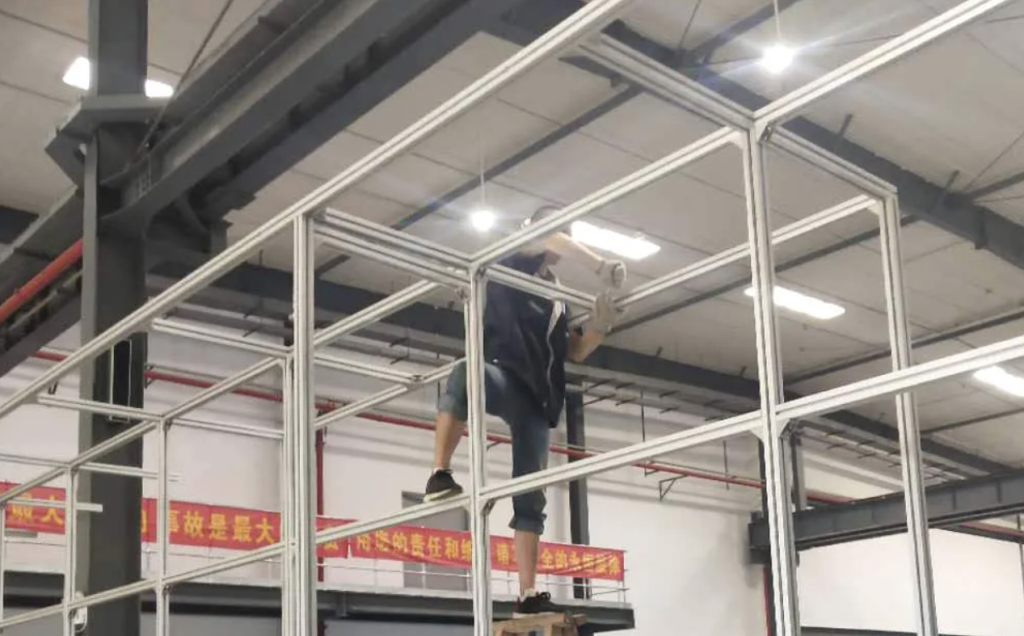Extruded Aluminum Frame Structure: Everything You Need to Know

What makes extruded aluminum frame structures so popular in modern industries? Their lightweight design, corrosion resistance, and flexibility make them a preferred choice for applications like industrial equipment, shelving systems, and display units.
In this guide, you’ll explore everything about extruded aluminum frames—from their manufacturing process to the benefits they provide across various sectors.
Key Components of Extruded Aluminum Frame Structures
Several essential components form an extruded aluminum frame structure, each fulfilling a specific purpose. These include aluminum profiles, end caps, connectors, and gaskets. Below is a breakdown of these elements and their roles in the structure:
Aluminum Profiles: Core Structural Components
Aluminum profiles form the foundation of the frame. They are selected based on load-bearing needs and application requirements. Profiles come in various types, such as T-slot or square profiles, allowing flexibility in design. For example:
- Heavy-duty profiles are ideal for machinery enclosures or industrial applications.
- Lightweight profiles work well for display stands or modular furniture.
End Caps: Securing Open Ends
End caps are used to seal the exposed ends of aluminum profiles. They provide two key benefits:
- Structural stability: Preventing movement or displacement of the profiles.
- Aesthetic appeal: Creating a clean, finished look by covering open edges.
Connectors: Joining Components Together
Connectors link aluminum profiles to create a unified framework. They come in various designs depending on structural requirements:
- Angle brackets: Used for simple 90-degree connections.
- T-slot connectors: Allow adjustable configurations for modular designs.
Gaskets: Enhancing Stability and Tightness
Gaskets improve the fit between connectors and aluminum profiles, ensuring stability and reducing vibrations. They also enhance tightness, preventing loosening over time during use.
Strength Calculation and Structural Design
The strength of an extruded aluminum frame depends on careful calculations and design planning:
- Engineers analyze load distribution to determine the right profile type and connector placement.
- For high-stress applications, reinforced profiles and heavy-duty connectors are used to ensure durability.
Key Benefits of Extruded Aluminum Frame Structures
These structures offer adaptability across industries such as manufacturing, architecture, and automation due to their modular design and lightweight yet durable materials. Whether you’re assembling workstations or custom enclosures, understanding these components ensures efficient construction tailored to specific needs.
By combining precision-engineered parts with thoughtful design, extruded aluminum frames deliver reliable performance for diverse applications.

Production Process of Extruded Aluminum Frame Structure
The production process for extruded aluminum frame structures follows a series of precise steps. Each stage is essential for ensuring the frame’s strength, stability, and functionality.
1. Cutting and Processing Aluminum Profiles
Aluminum profiles are cut to specific lengths based on engineering requirements. Additional processing, such as drilling or slotting, prepares the profiles for assembly. These modifications ensure the profiles fit seamlessly into the overall structure.
2. Assembling End Caps
End caps are attached to aluminum profiles to secure open ends and provide structural support. Their placement depends on the frame’s length and tension requirements. For example, reinforced end caps may be used for heavy-duty applications to enhance durability.
3. Installing Connectors
Connectors join aluminum profiles to form a sturdy framework. Common connector types include:
- Angle brackets: Ideal for simple corner connections.
- T-slot connectors: Allow adjustable configurations for modular designs.
Fasteners such as screws or bolts secure the connectors, ensuring a stable and reliable assembly.
4. Structural Design and Strength Calculations
Engineers perform structural design and load calculations to ensure the frame meets its intended performance requirements. This step includes analyzing:
- Weight distribution across the frame.
- Tension points that may experience stress during use.
- Environmental factors like vibration or temperature changes.
These calculations guide material selection and connector placement for optimal strength and stability.
5. Installing Gaskets for Stability
Gaskets, also known as shims, are placed between connectors and profiles to enhance tightness and reduce vibrations. They improve connection stability and prevent loosening over time, especially in dynamic environments like manufacturing systems or transport equipment.
Key Takeaways
This production process ensures that extruded aluminum frames are durable, adaptable, and suited for various applications. By following these steps, manufacturers create reliable structures that meet industry standards while allowing customization for specific needs.
This streamlined approach balances precision with efficiency, delivering high-quality frames tailored to diverse uses such as industrial machinery, modular workstations, or architectural frameworks.

Advantages of Extruded Aluminum Frame Structure
Flexible Assembly
Extruded aluminum frames are easy to assemble and adapt to different requirements. Their modular design allows users to combine components into various shapes and sizes, making them suitable for diverse applications such as industrial equipment, shelving systems, and architectural frameworks.
Lightweight Material
Aluminum frames are significantly lighter than steel, weighing only one-third to one-fifth as much. This lightweight property simplifies transportation and installation while reducing structural stress on foundations. It is particularly beneficial for mobile setups or projects requiring ease of handling.
Resistant to Corrosion
Aluminum naturally resists corrosion due to its protective oxide layer, which shields it from moisture, air, and most chemical agents. This durability ensures long-term performance in challenging environments, such as factories, coastal regions, or areas with high humidity.
Customizable Appearance
Extruded aluminum frames have a clean, modern look that can be enhanced with surface treatments like anodizing or powder coating. These options provide a variety of colors and finishes, allowing customization to match branding or design preferences while maintaining a professional appearance.
By combining flexibility, durability, and aesthetic appeal, extruded aluminum frames deliver practical solutions for industries ranging from manufacturing to construction. Their lightweight design and resistance to corrosion make them an efficient choice for both temporary and permanent structures.
Conclusion
Extruded aluminum frame construction offers a lightweight, durable, and versatile solution for modern structural needs. Its modular design allows for easy assembly and customization, making it ideal for applications such as industrial production lines, warehouse shelving, display racks, and cabinets.






